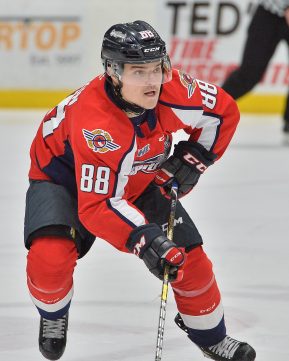While not overly large, Ruben Rafkin packs a punch as a physical two-way defender. Mobile and calculated, he plays a consistent and safe game with the puck, helping the Windsor Spitfires be a strong team in transition. His intelligence, aggressiveness, and skating ability makes him a very effective player in his own end. Rafkin has already signed back home for next year with TPS in Liiga, meaning his stay in the OHL was short lived. However, his projection as a versatile #4-5 defender makes him an attractive option to NHL teams in the middle rounds as they look to improve their organizational depth.
| Ruben Rafkin | 2020 NHL Draft Eligible |
|---|---|
| Position: D, Shoots: R | H/W: 6-0", 190lbs |
| Stats to Date: (GP-G-A-PTS-PIMS) | Windsor Spitfires, OHL (59-4-27-31-61) |
| Finland U18, Hlinka Gretzky Cup (3-0-1-1-2) |

Ruben Rafkin of the Windsor Spitfires. Photo by Terry Wilson / OHL Images.
Skating: Rafkin is a smooth skater who moves well in all four directions. He shows well exiting his zone by quickly evading forecheckers to carry the puck out himself, or by creating enough space to execute a strong outlet pass. In particular, Rafkin’s lateral pushes are strong. He will occasionally push deeper through the neutral zone, showing a solid top speed. As a defensive player, he keeps a wide base while being fluid, making him difficult to get around in transition. This is crucial given his average size and reach. He is also quick to recover dump ins, showing the ability to go backwards to forwards smoothly. Grade: 55
Shot: Rafkin is definitely a pass first defender who does not possess a high end shot, or extreme confidence in using it. When patrolling the point, it is rare to see him cycle down to play deeper into the offensive zone, instead holding his position. He possesses an accurate low wrist shot, but he is much more likely to use his mobility to create a passing lane than a shooting lane. As an example, his shots per game (1.14) was 15th among first time draft eligible defenders in the OHL, with many of those ahead of him not being NHL prospects. As Rafkin becomes stronger and more confident, I would expect that his shot progresses to become league average. Grade: 50
Skills: As mentioned, Rafkin is a confident puck carrier who handles the pressure of the forecheck well. He is not big, but he usually protects the puck well through changes of direction, allowing him to push forward across his blueline or deeper. Added strength on the puck would help him avoid being pushed off the puck in the defensive zone, as he can occasionally have difficulty with the forecheck. On the point, he does a good job keeping pucks in and walks the line well. However, Rafkin is not an exceptionally skilled defender. He plays a pretty safe two-way game. He will push the pace when he can, but rarely pinches deep into the offensive zone. He will not dazzle you with his offensive skill set. Grade: 50
Smarts: A strong and confident two-way defender, Rafkin’s IQ at both ends is quite high. It is rare to see him turn the puck over once he escapes the forecheck as he is calculated when attempting to push the pace. He will not try to go through defenders or force plays through traffic, instead opting to use chip outs, dump ins, drop backs, or a heads up pass when pressured. Defensively, he has excellent gap control when defending in transition, balancing an aggressive physical approach with patience and poise. This is possible because of his mobility. It is also rare to see him get lost in coverage, as he recovers well, even when he is assertive in taking the body. Grade: 55
Physicality: Not massive by any means (6-0”, 180lbs), Rafkin packs a serious punch as a physical player. While he may not be aggressive as an offensive player, he is aggressive physically by stepping up on attackers in the neutral zone and around the blueline to disrupt zone entry attempts. Rafkin also makes his physical presence known when battling along the wall, where he engages physically to separate his man from the puck and does well to win the majority of his one on one battles. However, he is also intelligent in using his physicality, as he rarely gets himself taken out of position going for a hit. His intensity level in the defensive end makes him a difficult player to match up against. Grade: 55
Overall Future Projection (OFP): 53.5
A note on the 20-80 scale used above. We look at five attributes (skating, shooting, puck skills, hockey IQ and physicality) for skaters and six for goalies (athleticism/quickness, compete/temperament, vision/play reading, technique/style, rebound control and puck handling). Each individual attribute is graded along the 20-80 scales, which includes half-grades. The idea is that a projection of 50 in a given attribute meant that our observer believed that the player could get to roughly NHL average at that attribute at maturity.